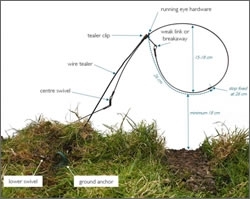The importance of conducting proper scientific research was highlighted in this week’s Backbench Business debate in the House of Commons about snaring – both sides of the debate making use of the GWCT’s evidence. So what were they reading?

What is the central issue?
Snares are considered valuable for the control of foxes, but they have been criticised for perceived low target selectivity and poor animal welfare. This has driven further research, which has resulted in changes in snare design, codes of practice (Wales and Scotland) and legislation (Scotland).
Are there direct alternatives to snares?
No. There are no functional replacements yet that match the advantages of a snare. Despite their shortcomings, this is precisely why some important conservation projects use them to help control foxes – including the ten-year study to recover Langholm Moor (funded by Buccleuch Estates, Scottish Natural Heritage, the Game & Wildlife Conservation Trust, the RSPB and Natural England).
Are snares used in the UK designed to kill?
No. Snares are a live-capture device used by gamekeepers and farmers (in similar numbers). They are designed to catch and hold a fox1 without injury until it is dispatched humanely (or released if it is a non-target)2. Snares are regulated through both legislation and codes of practice. Their use is limited by the Wildlife & Countryside Act (1981) and subsequent devolved legislation.
Can a snare really catch an animal alive and uninjured?
Yes. We know this because biologists have used snares for decades, as an efficient way to catch foxes and badgers alive in order to fit radio tags to study their ecology (in some cases recapturing them). Used in this way, injuries are rare. After release, tagged animals show no abnormal behaviour, survive normally and breed normally.
Is there a humaneness standard for trapping, and how do snares compare?
Fox snares, correctly used, meet the humaneness standards for restraining traps defined in the Agreement on International Humane Trapping Standards (AIHTS)3. In contrast, the common mouse trap does not.
What did the MPs decide?
For those with the time the online Hansard can be read here. Therese Coffey, who has recently replaced Rory Stewart, responded for the government. She explained that the new best practice guidelines and well-designed snares “can tackle a lot of these issues”. She also added that the government will publish the new snaring code for England “very soon”.
The way forward
The GWCT welcomes the news that the new code of practice for snaring in England will be published soon. It is based on the latest research and has been carefully drafted by a wide range of organisations. The GWCT position on snaring can be read here.
Get your FREE fox snaring guide from the GWCT team
Simply click here to download your essential free guide >
 What's inside your FREE fox snaring guide
What's inside your FREE fox snaring guide
✓ Fox control: Is it important?
✓ What are the alternatives to snaring?
✓ The main components of a well-designed snare
✓ Fox snares: Hardware vs practice
✓ Key controversies
Footnotes
1 97% of snare use in the UK is for fox control. To a much smaller extent they are used in rabbit control. It is lawful to use snares to target several other mammal species (e.g. hare, rat, mink) but in fact this is rarely done. Gamekeepers and a similar number of farmers use snares across 6% of landholdings in England and Wales.
2 Self-locking snares designed to kill were banned in the UK in 1981. In other regions, for example North America, the term “snare” also refers to a device intended to kill. The design and mode of use are different.
3 AIHTS is an agreement between the EU, USA, Russia and Canada defining humaneness standards for traps that capture mammals commonly traded for their fur. Technically, neither fox snares nor mouse traps are required to meet the AIHTS standard, but in the absence of a universal standard for all traps the AIHTS is often referred to as a yardstick for humaneness.